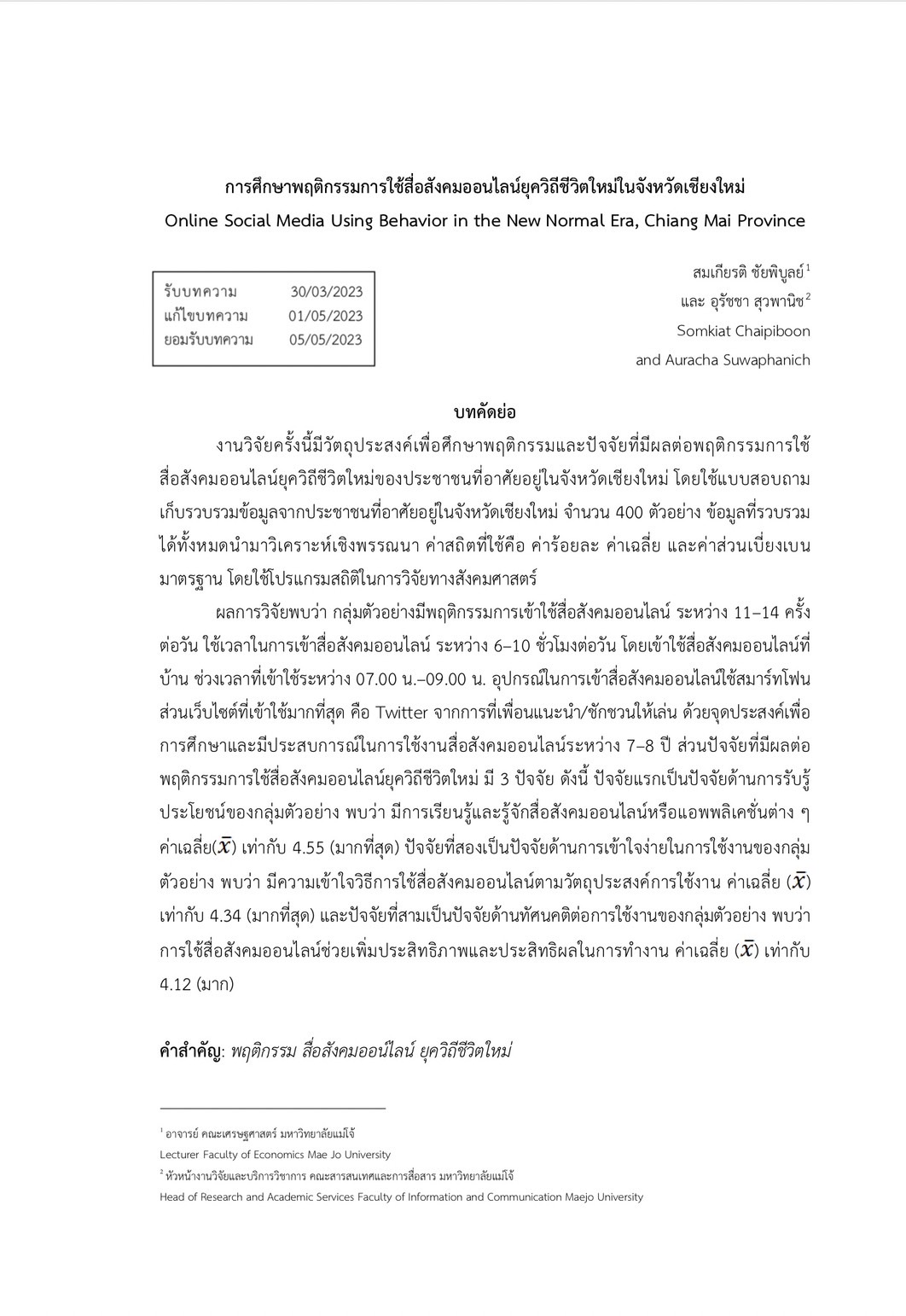Online Social Media Using Behavior in the New Normal Era, Chiang Mai Province
Keywords:
Behavior, online social media, new normal eraAbstract
This study was conducted to investigate behaviors and factors effecting online social media using behaviors in the new normal era of people living in Chiang Mai province. A set of questionnaires was used for data collection administered with 400 people and analyzed by using descriptive statistics: percentage, mean and standard deviation.
Results of the study. Revealed that the respondents used online social media around 11–14 times or 6–10 hours per day. They used it at home during 07.00-09.00 a.m.; smart phone was the equipment found most and twitter was the website found most. The respondents were suggested or persuaded to use online social media by friends. They aimed to learn and have experience in social online media using. Three factors were found to have an effect on online social media using behaviors. First, perception of benefits-learning / knowing online social media or various applications ( =4.55, a highest level). Second, easy to understand and use-online social media using method based on the using objective ( =4.34, a highest level). Third, attitudes towards online social media using-increased efficiency and effectiveness of working performance ( =4.12, a high level).
References
กัลยา เขียวเปลื้อง. (2563). พฤติกรรมของประชาชนในการรับรู้เครือข่ายสื่อสังคมออนไลน์ของสำนักงานประชาสัมพันธ์ จังหวัดกาญจนบุรี. วารสารบัณฑิต
วิทยาลัย มหาวิทยาลัยราชภัฏจันทรเกษม, 16 (2), 79-93.
ครองรัตน์ ดุลลาพันธ์. (2561). พฤติกรรมการใช้เครือข่ายสังคมออนไลน์และปัจจัยทางจิตพยากรณ์. วิทยานิพนธ์ศิลปศาสตรมหาบัณฑิต สาขาวิชานิเทศศาสตร์
และนวัตกรรม บัณฑิตวิทยาลัย สถาบันบัณฑิตพัฒนบริหารศาสตร์.
ณิชกุล เสนาวงษ์. (2564). การศึกษาพฤติกรรมการใช้สื่อสังคมออนไลน์ของคนเจนเนอเรชั่นแซด ในยุค New Normal ในกรุงเทพมหานคร. การค้นคว้าอิสระ
บริหารธุรกิจมหาบัณฑิต สาขาวิชาการตลาด บัณฑิตวิทยาลัย มหาวิทยาลัยสยาม.
ณัฐวดี บุญวัฒโนภัส. (2559). การใช้สื่อสังคมออนไลน์และการรู้เท่าทันสื่อสุขภาพของเยาวชนในอำเภอเมืองภูเก็ต. วารสารวิชาการมหาวิทยาลัยอีสเทิร์นเอเชีย
ฉบับวิทยาศาสตร์และเทคโนโลยี, 10 (3), 48-62.
วราพร ดำจับ. (2562). สื่อสังคมออนไลน์กับการเรียนรู้ในศตวรรษที่ 21. วารสารศิลปศาสตร์ มหาวิทยาลัยแม่โจ้, 7 (2), 143-159.
สำนักงานพัฒนาธุรกรรมทางอิเล็กทรอนิกส์. (2565.) รายงานผลการสำรวจพฤติกรรมผู้ใช้อินเตอร์เน็ตในประเทศไทย ปี 2565. กรุงเทพฯ: กระทรวงดิจิทัลเพื่อ
เศรษฐกิจและสังคม.
สุดารัตน์ ดิษยวรรธนะ และจันทรา วัฒนากุล. (2555). รู้เท่าทันโซเชียลมีเดีย. กรุงเทพฯ: ออฟเซ็ทพลัส.
สำนักงานสถิติแห่งชาติ. (2563). รายงานการสำรวจการมีการใช้เทคโนโลยีสารสนเทศและการสื่อสารในครัวเรือน พ.ศ. 2563. กรุงเทพฯ: สำนักงานสถิติแห่งชาติ.
หยาดพิรุณ ศุภรากรสกลุ. (2558). พฤติกรรมการใช้เครือข่ายสังคมออนไลน์และผลกระทบต่อ นักเรียนระดับมัธยมศึกษาในจังหวัดเพชรบูรณ์. วารสาร
มนุษยศาสตร์และสังคมศาสตร์ มหาวิทยาลัยอุบลราชธานี, 8 (2), 53-71.
Chen, H. & Wu S. J. (2018). Purchase intention in social commerce: Anempirical examination of perceived value and social awareness.
Library Hi Tech.
Ooi, K. B. & Tan, G. W. H. (2016). Mobile technology acceptance model: An investigation using mobile users to explore smartphone
credit card. Journal of Expert Systems with Applications, 59 (1), 33-46.
Yamane, T. (1973). Statistic: An introduction analysis (3rd ed.). New York: Harper and Row.

Downloads
Published
How to Cite
Issue
Section
License
Copyright (c) 2024 Journal of Humanities and Social Sciences Nakhon Pathom Rajabhat University

This work is licensed under a Creative Commons Attribution-NonCommercial-NoDerivatives 4.0 International License.
Journal of Humanities and Social Sciences Nakhon Pathom Rajabhat University





